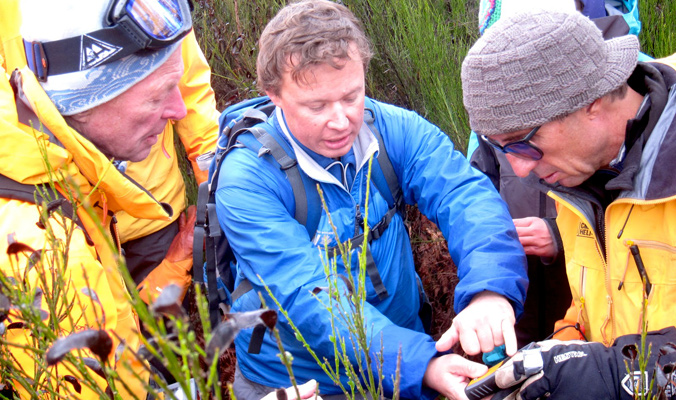Is it safer to be a backcountry skier now than it was 20 years ago? It’s a complicated question, but most snow-safety gurus believe the answer is yes. We spoke with eight leaders in avalanche mitigation and rescue about the progress made—and challenges that remain—since Backcountry premiered.
Manuel Genswein, 40, is a native of the Swiss Alps who lives in Meilen and has done snow-safety work in 29 countries. Using an electronic engineering background, he has also developed rescue products and techniques that have been applied around the world. Here’s an excerpt from our conversation on 20 years of education, safety and snow science.

Manuel Genswein talks beacon tech in Nakusp, B.C. [Photo] Gery Unterasinger
The bigger change on the forecasting side has been how we disseminate the information. Twenty years ago, many countries issued one bulletin a week. And now several countries have two bulletins a day, one in the morning and one in the evening. You get it for free, everywhere, on your smartphone.
Same goes for rescues. Technology has changed—I helped invent a dangling beacon that you can hang from helicopters and search a debris field from above. It has saved lives in many countries, because you’re faster, you search very complex terrain zones, there’s no extra effort and you greatly reduce exposure of rescuers to the terrain.
Again, though, our strategies have changed even more. We have quantitatively analyzed and optimized how to probe, how to excavate a buried subject, how to apply the search devices in different search phases. We understand much better what really leads to success.
Before 2006, nobody really taught shoveling in avalanche rescues; it was still possible to make the excavation at least 50 percent more efficient than how it had been done before. We developed a conveyor-belt, V-shaped group shoveling method that works with a small or larger team of rescuers. So not only do you make them shovel the greatest quantity of snow per minute per rescuer, but every few minutes. The rescuer working at the tip of the V, close to the probe, shouts, “Rotate!” and everybody rotates clockwise. By doing this you never run the rescuer into the exhaustion curve, where exhaustion starts to steepen. So they last much longer.
[Author’s note: Genswein’s conveyor-belt method has been adopted by rescue teams around the world and is now taught to the public. Says Ilya Storm: “There was one case in B.C. where some guys took a course in November, and two weeks later they dug their buddy out alive more than two meters deep super fast. So don’t underestimate the importance of something like Manuel’s conveyor shoveling.”]
—
This story was first published in the November 2014 issue. Find the other conversations in this series here.











Related posts:
Mountain Skills: How to Prepare for Your Level 1 Avalanche Course
Mountain Skills: Anticipating Point Release Avalanches
Mountain Skills: How to really read the avalanche forecast
Mountain Skills: Exploring with Modern Navigation Tools